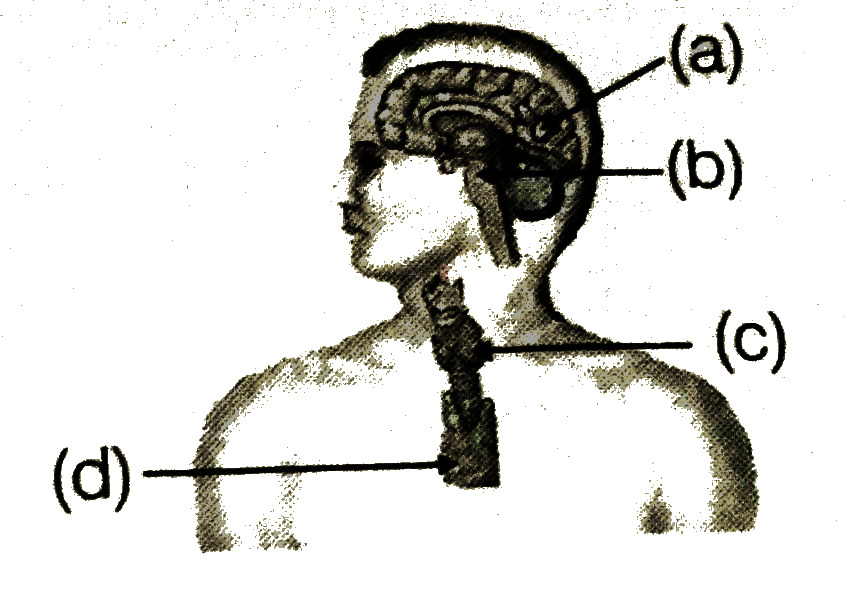Why are endocrine glands called ductless glands ?
Step-by-Step Solution:
1. Definition of Endocrine Glands: Endocrine glands are specialized organs that secrete hormones directly into the bloodstream rather than through ducts.
2. Lack of Ducts: Unlike exocrine glands, which have ducts to transport their secretions (like saliva or digestive enzymes), endocrine glands do not possess any ducts. This absence of ducts is a key characteristic that defines them as "ductless."
3. Hormone Secretion: The hormones produced by endocrine glands are released directly into the circulatory system. This allows them to travel throughout the body and reach their target organs or tissues, where they exert their effects.
4. Examples of Endocrine Glands: Some common examples of endocrine glands include:
- Hypothalamus: Regulates the endocrine system.
- Pituitary Gland: Often referred to as the "master gland," it controls other endocrine glands.
- Thyroid Gland: Regulates metabolism.
- Adrenal Glands: Involved in stress response and metabolism.
- Pancreas: Regulates blood sugar levels.
5. Functions of Endocrine Glands: Endocrine glands play crucial roles in various bodily functions, including:
- Growth and development
- Metabolism regulation
- Tissue function control
- Sexual function and reproduction
Summary:
Endocrine glands are called ductless glands because they do not have ducts to transport their secretions; instead, they release hormones directly into the bloodstream, allowing for widespread distribution and regulation of various physiological processes.
---
- Hypothalamus: Regulates the endocrine system.
- Pituitary Gland: Often referred to as the "master gland," it controls other endocrine glands.
- Thyroid Gland: Regulates metabolism.
- Adrenal Glands: Involved in stress response and metabolism.
- Pancreas: Regulates blood sugar levels.
- Growth and development
- Metabolism regulation
- Tissue function control
- Sexual function and reproduction
Endocrine glands are called ductless glands because they do not have ducts to transport their secretions; instead, they release hormones directly into the bloodstream, allowing for widespread distribution and regulation of various physiological processes.
Topper's Solved these Questions
- CHEMICAL COORDINATION AND INTEGRATIONBook:AAKASH INSTITUTE ENGLISHChapter:CHEMICAL COORDINATION AND INTEGRATIONExercise:Try Yourself
Explore 68 Videos
- CHEMICAL COORDINATION AND INTEGRATIONBook:AAKASH INSTITUTE ENGLISHChapter:CHEMICAL COORDINATION AND INTEGRATIONExercise:EXERCISE
Explore 30 Videos
- CELL:THE UNIT OF LIFE Book:AAKASH INSTITUTE ENGLISHChapter:CELL:THE UNIT OF LIFE Exercise:Try Yourself
Explore 26 Videos
- DIGESTION AND ABSORPTION Book:AAKASH INSTITUTE ENGLISHChapter:DIGESTION AND ABSORPTION Exercise:Assignment (SECTION-D Assertion - Reason Type Questions )
Explore 10 Videos
Similar Questions
The ductless glands
View SolutionLargest endocrine gland in humans
View SolutionRead the following statements (Statement A: Endocrine glands are ductless amd release their secretion into the venous blood,Statement B: Endocrine system is slower than nervous system in terms of coordination and regulation) Choose the correct option
View SolutionWhich glands are called endocrime glands ?
View SolutionWhich of the following does not act as an endocrine gland as well as an exocrine gland?
View SolutionWhy are adernal glands also called suprarenals ?
View SolutionEndocrine gland-Pineal gland
View SolutionThe largest endocrine gland in human is
View SolutionLabel the endocrine gland in figure

View SolutionThe endocrine glands that produces somatostatin also produces
View Solution

